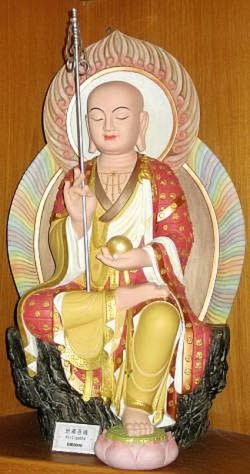Difference between revisions of "Summary of the Mahayana school"
(Created page with "thumb|250px| <poem> Summary of the Mahayana school [摂論宗] (Chin She-lun-tsung; Jpn Shoron-shu) One of the thirteen Buddhist schools said to have ex...") |
|||
| Line 1: | Line 1: | ||
[[File:Es35.jpg|thumb|250px|]] | [[File:Es35.jpg|thumb|250px|]] | ||
<poem> | <poem> | ||
| − | Summary of the Mahayana school | + | Summary of the [[Mahayana]] school |
[摂論宗] (Chin She-lun-tsung; Jpn Shoron-shu) | [摂論宗] (Chin She-lun-tsung; Jpn Shoron-shu) | ||
| − | + | One of the thirteen Buddhist schools said to have existed in China. A school based on [[Asanga]]'s Summary of the [[Mahayana]] that expounds the Consciousness-Only doctrine. This school upholds the doctrine of the nine consciousnesses; it defines the first eight consciousnesses as the realm of delusion and regards the ninth, the amala-consciousness, as the realm of perfect purity. In the sixth century, Paramartha, a monk from western India, brought the Sanskrit texts of The Summary of the Mahayana and Vasubandhu's Commentary on "The Summary of the Mahayana" to China and translated them into Chinese. Thereafter Paramartha's followers propagated the doctrine of The Summary of the Mahayana, and as a result, the Summary of the Mahayana (Shelun) school was formed. Paramartha is regarded as the founder. In the mid-seventh century, Hsüan-tsang made a new translation of The Summary of the Mahayana, and his disciple Tz'u-en founded the Dharma Characteristics (Fa-hsiang) school, which also taught the Consciousness-Only doctrine. Thereafter the Summary of the Mahayana school gradually declined. | |
</poem> | </poem> | ||
{{R}} | {{R}} | ||
Revision as of 08:55, 15 May 2013
Summary of the Mahayana school
[摂論宗] (Chin She-lun-tsung; Jpn Shoron-shu)
One of the thirteen Buddhist schools said to have existed in China. A school based on Asanga's Summary of the Mahayana that expounds the Consciousness-Only doctrine. This school upholds the doctrine of the nine consciousnesses; it defines the first eight consciousnesses as the realm of delusion and regards the ninth, the amala-consciousness, as the realm of perfect purity. In the sixth century, Paramartha, a monk from western India, brought the Sanskrit texts of The Summary of the Mahayana and Vasubandhu's Commentary on "The Summary of the Mahayana" to China and translated them into Chinese. Thereafter Paramartha's followers propagated the doctrine of The Summary of the Mahayana, and as a result, the Summary of the Mahayana (Shelun) school was formed. Paramartha is regarded as the founder. In the mid-seventh century, Hsüan-tsang made a new translation of The Summary of the Mahayana, and his disciple Tz'u-en founded the Dharma Characteristics (Fa-hsiang) school, which also taught the Consciousness-Only doctrine. Thereafter the Summary of the Mahayana school gradually declined.
